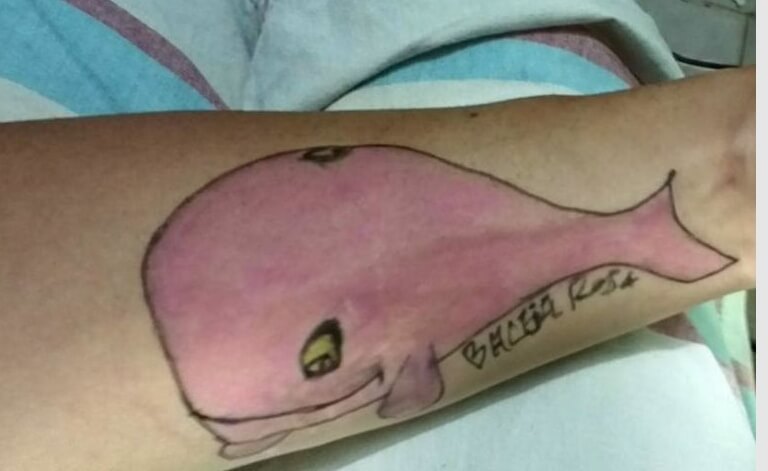The Blue Whale Game: Suicide and Children


Written and verified by the psychologist Gema Sánchez Cuevas
No one wants to commit suicide. In fact, the majority of people who take that step are convinced they have no other possible way out. It’s their last resort, their last place to turn to escape a painful life.
The grim “blue whale” game completely baffles most of us, but there is an crucial point here: in our world today there are thousands of children and teenagers floating through dark waters of sadness, loneliness, and vulnerability. They need help.
Maylen is 13 years old and lives in a small town in Colombia. Her life seemed normal, not much different than any other kid the same age. A few days before she committed suicide by hanging herself with a belt, she asked her mother if blue whales existed.
“They do exist, and there probably aren’t many left. They’re going extinct,” answered Mrs. Villamizar, who couldn’t have imagined what was in her daughter’s mind.
“One of the main tasks of being a teenager is to find an identity. Not necessarily an understanding of who we are, but at least some clarity about who we could become.”
-Anonymous-
Maylen isn’t the only one who took that step. There have been nearly 130 young people all over the world who have completed the 50 awful steps in this “game.”
In this game, you win by completing a “final mission.” This mission is to take your own life. To add horror to horror, if they don’t, the game warns that once it figures out the user’s IP address, other people could murder their friends and families.
A lot of people will say that the world of social media and virtual communities is evil. But behind all that there’s one particular thought that stands out: the world, whether we believe it or not, is full of blue whales. They’re precious, vulnerable creatures that represent those things we’re unconsciously or purposefully neglecting: loneliness, fear, insecurity…
It’s time to decide. The opposite of the “blue whale” is the “pink whale.” The pink whale a wonderful initiative that came about as a reaction to the blue whale game that’s unfortunately taking the lives of very young people.

Blue whales try to get out of a painful life
Strangely, the game’s name has very little to do it the precious animal it’s named after. The blue whale is the largest animal on our planet. They’re graceful swimmers and cross oceans extremely quickly.
They’re also the loudest animals on our planet. They can emit pulses, grunts, and moans that can be heard more than 900 miles away. They are, possibly, one of the most fascinating creatures in nature.
But our “blue whales,” the ones swimming on asphalt ground and in the world of social media, are silent creatures. They’re people who go unnoticed. They’re also characterized by a certain psychological vulnerability and a lack of stable role models.
When ask how a 12, 13, or 18 year old person might decide to start playing this game where they’re asked to do humiliating, painful things, we should keep in mind a few aspects.

Why would a young person decide to take part in the game?
The blue whale game gives children and teenagers a chance to be unique in a world where they feel invisible. It’s a world where many of them can’t find their place or anything to set them apart.
Every act of self-harm, every awful challenge beaten becomes an achievement. They see them as acts of bravery because they’ve beaten pain, fear, indecisiveness… They’re “victories” that they post proudly to get some psychological reinforcement and motivation. The motivation to keep going.
Plus the mere act of starting this kind of game makes them feel like part of something. It’s a project that comes with commitment.
We can’t forget that being a teenager is a period of life full of searching where if the young person doesn’t have a solid group of friends or a family to give them stability and security, they’ll look anywhere to protect themselves from loneliness. And sometimes they look in the worst places possible.
In the end, the blue whale game offers these children and teenagers a long journey full of awful challenges. The challenges are supposedly going to support their self-esteem. But what the kids don’t know is that they’re at the mercy of the sadistic, cruel whims of the people behind the game.
Blue whales can turn pink
We have to wake up: there’s more than one blue whale swimming around us. But you should be careful not to scare them or criticize who they are, for feeling how they feel or being curious about the game.
Because when you punish, judge, or make fun, the blue whale will swim away from you. You have to guide them carefully, warmly, and intelligently so that, with your help, they turn into a pink whale.
“Adolescence is a new birth, for the higher and more completely human traits are now born.”
-G. Stanley Hall-
As the WHO explains, nearly 4% of the population suffers from depression. And every year there are more than 800,000 people who choose to take their life. For them it’s the only way to stop suffering. A big part of that number is made up of young people between 13 and 25 years old. On top of that, there are nearly 16 million people who self-harm, especially teenagers.
That’s why we have to focus on changing how we raise and educate our children. We need more tools in schools and definitely more programs like the Pink Whale Challenge. The pink whale challenge intends to foster a positive attitude via 50 fun tests. Every step of the way involves a new start to life — not an unhappy ending.

Prevention and supervision
The family plays a vital role in these scenarios. So let’s keep these guidelines in mind as we go:
- Parents need to be completely emotionally available when it comes to listening to their children.
- The current economic recession is making it harder in a lot of countries for families to spend time together. But what little time we do have should be quality time. This way we can build good trust and intimacy with children.
- We have to give children the opportunities and tools to create significant relationships with their peers, always watching out for isolation.
- We have to remember the necessity of valuing our children and giving them positive reinforcement so they’ll have strong self-esteem.
Last but not least, we have to pay attention to their mood and behavior changes. We also need to regularly supervise what they’re doing and sharing on their social media. This part is key to avoiding situations like the awful ones happening all around us, closer than we think.
This text is provided for informational purposes only and does not replace consultation with a professional. If in doubt, consult your specialist.








